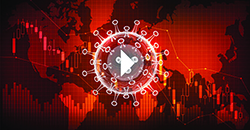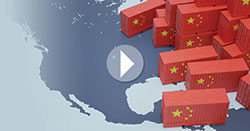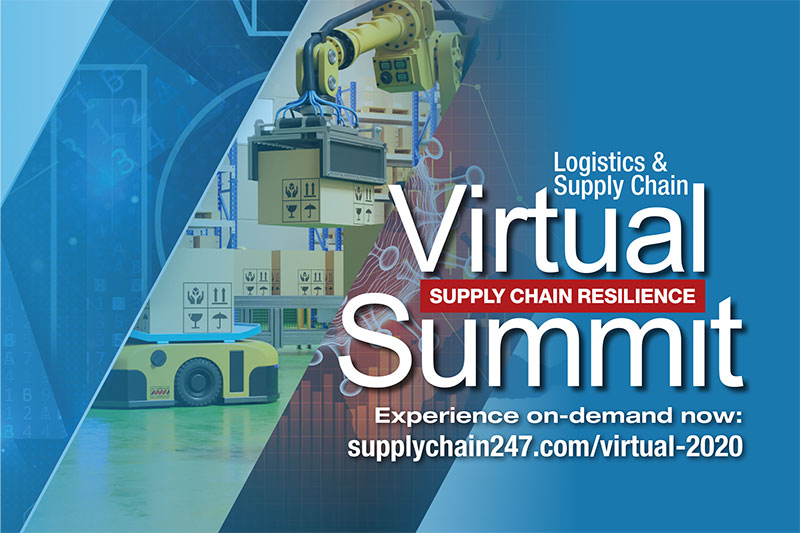Keynote: Rethinking risk and resilience in the aftermath of the pandemic
 A major shock to supply chain operations, COVID-19 exposed the weaknesses of the current supply chain paradigm and forced firms to consider the challenges of rebuilding their supply chains due to supplier exits.
A major shock to supply chain operations, COVID-19 exposed the weaknesses of the current supply chain paradigm and forced firms to consider the challenges of rebuilding their supply chains due to supplier exits.
For some industries, the pandemic even forced a major rethinking of business models. And while these are all valid pain points, there’s a silver lining to all of this: The pandemic is giving companies a chance to rethink supply chain resilience.
In this keynote session, Steven Melnyk, professor of operations and supply chain management at Michigan State University, discusses how companies will rebuild while also creating a better, stronger supply chain for the future. After all, the foundations for doing so have been there all along, and most systems and people are ready for change.
In his presentation, Melnyk highlights risk and resilience, examines the risk impacts from COVID-19, and shows what risk and resilience 2.0 will look like post-COVID. “The current situation has accelerated certain developments, which were present prior to the pandemic,” he says, “but which have now been exposed or opened as a result of the pandemic.”
Defining supply chain risk and resilience as “the ability of a supply chain to both resist disruptions and recover operational capabilities after disruptions occur,” Melnyk says the two major capabilities are resistance and recovery, both of which are measured along with time, quantity, strategy, and stock price. “Economically,” he notes, “the pandemic has been a disaster.”
The hidden, overlooked impacts of COVID-19 include the vulnerability of small- to medium-sized businesses, which bore the burden of pandemic. These small businesses are extremely important to the supply chain, he explains, even though they are often “hidden.”
Looking ahead, Melnyk says companies must rethink risk and resilience by managing multi-tier supply chains—a weak point for many. “The new form of resilience builds on prioritization, being a good customer, and supplier development,” says Melnyk, who wraps up the keynote with a list of success tips for 2021 and beyond.
He ends his session with this piece of sage advice to all supply chain operators and logistics leaders: “We have to stop thinking in silos, and we have to work toward a collaborative supply chain.”
Session 1: Digital Transformation
How the pandemic accelerated supply chain technology trends 
The push to integrate more technology and automation into the supply chain was already well underway pre-COVID, with the unexpected health crisis—and subsequent supply chain shocks—greatly accelerating the trend.
For example, technologies such as the Internet of Things (IoT), artificial intelligence (AI), robotics, real-time data analytics and communications platforms that facilitate telecommuting all provide visibility into supply chains and also enable contactless, paperless operations. And while these technologies were used to deal with the immediate impacts of the pandemic, they will also have long-term benefits for the performance and resilience of supply chains and businesses.
In this session, Yossi Sheffi, the director of the MIT Center for Transportation and Logistics, examines how the pandemic has accelerated the development and adoption of these technologies and the implications they have for supply chain resilience—both now and in a post-pandemic world.
“Every disruption is different,” says Sheffi. “It comes with its own litany of causes and effects and problems. No two are the same.” He goes on to say that risk management involves prevention, detection, and response. Many companies have some kind of emergency management, he adds, be it physical or virtual (the latter of which came about due to the pandemic).
To address crisis management, Sheffi says companies need good communication with customers, suppliers, employers, and beyond. “Even if you don’t have all the information, good communication includes what we know, what we don’t know, and what we’re working with,” says Sheffi. “This helps with uncertainty.”
Pointing out that many companies have had to make COVID adjustments (i.e., moving their operations online), Sheffi says IKEA now has an augmented reality app to see what items look like in your home, and Sephora is giving beauty tutorials online instead of in-store makeovers. “This is the supply chain professionals’ finest hour,” he explains, “and a time where they can step up to solve these challenges.”
Session 2: Research
29th Annual Study of Logistics and Transportation Trends 
The speed of technological and societal change no longer affords companies the luxury of slow incremental improvements or adaptations. Instead, logistics and supply chain managers must look forward and dare to ask the hard question: Are we willing to change?
The “29th Annual Study of Logistics and Transportation Trends” posed this question to logistics and transportation professionals to gain added insights into how organizations are responding to the disruptive pressures of new technology, rising customer expectations, and a global pandemic.
In this session, Christopher A. Boone, Ph.D., assistant professor at Mississippi State University and Karl B. Manrodt, Ph.D., professor at Georgia College and State University, review the survey results, discuss key trends, and offer recommendations for current and future supply chain success.
“Most respondents think transportation is fundamentally changing,” says Manrodt. “The majority also agree that they will see an increase in funding for transportation, too. Normally that’s not the case, and usually they’re just on their own when it comes to dealing with change.”
Boone says that we’re also seeing a shift in meeting customer expectations and that’s driving the shift into smaller individual orders and shipments. “This is how companies are responding to customer expectations,” he explains, “and the impact that’s having on how they’re spending transportation dollars.”
The speakers then discuss types of technology companies are looking at this year, such as visibility, predictive analytics, AI, robotics, electronic bills of lading, and the Internet of Things. They say funding for transportation technology initiatives is increasing and that, across the board, “everyone should be investing more in technology than they did in the past.”
“COVID is a catalyst both on the carrier side and the shipper side for transformational transportation projects,” says Manrodt. For instance, he says companies really need to think more about partnerships and working together to be successful.
Technology will serve as the catalyst that helps solidify those alliances and that puts companies on the path to success. “Technology isn’t just enabling us to do some of the things we’re doing now a little bit faster or a little bit better,” says Boone, “it’s really giving us the opportunity to rethink how we can do things completely differently.”
Session 3: Software
TMS: Essential to efficiency 
Especially amid disruption, transportation management systems (TMS) help companies carve out a path for efficiency and productivity for their modern supply chains. For supply chain operations, end-to-end transportation visibility increasingly includes TMS integration with upstream and downstream systems, as well as granular data analysis to prioritize and optimize shipments.
In this session, Howard Turner, project director at St. Onge Company, takes a closer look at how businesses of all sizes can use TMS solutions to drive efficiency and flexibility while proactively positioning themselves for success.
Turner starts with a quick overview of TMS and its capabilities, noting that the software manages inbound, internal, and outbound shipments. Transportation networks are extremely complex with multiple suppliers and stakeholders that can be hard to manage, he says, and increasing visibility and securing transportation capacity are extremely important in the current landscape.
“A TMS is a tool that assists with analyzing and determining the optimal means to achieve your transportation goals,” Turner points out, noting that the software is typically integrated into the enterprise resource planning (ERP) system, then can be downloaded to a warehouse management system (WMS) for fulfillment.
Explaining that on-premises and Cloud TMS deployments come with their own pros and cons, Turner says that either option can handle the consolidation of orders for larger shipments, transportation optimization, real-time tracking, carrier performance measurement, transportation planning, and process automation (among other functionalities).
“Strategically investing in and properly deploying the right systems can allow your business to withstand and potentially thrive in an ever-changing landscape,” Turner concludes. “Properly using tools to navigate transportation disruptions can have a direct impact on your company’s bottom line.”
Session 4: E-commerce
Last-mile fulfillment: Solving an ever-complex puzzle 
COVID-19 accelerated the move to e-commerce for everything from groceries to classic cars, challenging existing B2B and B2C supply chain models. Amid this disruption, a flurry of innovation has thrived, including ship-from-store, curbside pickup, and hyper-local fulfillment, all of which have gone from fringe to mainstream.
Concurrently, new last-mile delivery models are shaking up the balance of power in package delivery. Alan Amling, a fellow at University of Tennessee and CEO at Thrive and Advance, LLC, uses this time to explore the emerging last-mile landscape—from fulfillment to the front porch—and provide alternatives to consider as companies navigate a world where disruptions are the rule, and not the exception.
COVID-19 has accelerated e-commerce by five years in just five months, Amling says. It has also boosted innovation, with supply chain companies and retailers innovating and pivoting to keep up with changing customer demands. “There has been sort of a butterfly effect,” he explains, “where one small change has built up into a larger impact. These small changes compound to produce industry shaking impacts.”
Amling then discusses the distinct e-commerce leaders that are setting the pace, like Walmart and Amazon. They are setting the bar on service when they do things like moving from two-day to one-day shipping or Walmart doing same day delivery for groceries, he notes. “As a result, new last-mile fulfillment models are taking shape, such as ship from store and drone delivery.”
Pointing out that the future of delivery revenue goes beyond just shipping and delivery cost, Amling says smart companies are “playing offense,” versus attempting to defend their territory. “This is the era of organizational velocity,” he adds, “which is the ability to observe, accept (or not), and act (or not) on threats and opportunities facing the firm with speed and agility.”
Session 5: Robotics
State of robotics: Consider robotics in 2021
 Robots, including autonomous mobile robots (AMRs), are seeing a rapid uptick in logistics and supply chain operations, with their usage projected to increase as the world recovers from the pandemic.
Robots, including autonomous mobile robots (AMRs), are seeing a rapid uptick in logistics and supply chain operations, with their usage projected to increase as the world recovers from the pandemic.
In this session, presenter Jeff Hedges, president at JHedges Consulting, offers attendees an in-depth look at the different types of robots coming into the market, and examines the value proposition behind these various approaches. He also explores how operations can better tie robotics in with automation and the workforce as logistics and supply chain operations work to build their long-term resilience strategy.
“There’s a lot of hope and a lot in interest in these technologies as we see dozens, if not hundreds, of venture capitalists and private equity firms continuing to invest,” says Hedges, who estimates that the robotics market will reach $4 billion by 2025. The industry is also seeing more investment in AI, even as a standalone technology, he adds.
Explaining that autonomous mobile robots (AMRs) are vehicles made to transport an item from point A to point B, Hedges says these vehicles don’t eliminate the picker; they just decrease travel time. Picking robots are made with more of an item picking focus, and are improving in the area of handling or sorting returns, kit assembly, and order verification and accuracy, while also making operations more cost effective.
During the coming year, Hedges expects labor availability to be a major concern—yet another reason why more companies are turning to robotics for help. “We’re past the early adopter phase,” he says. “Companies are definitely accelerating implementation plans.”
Session 6: Reshoring
Global strategy: The pros and cons of reshoring 
High transportation costs, supply chain interruptions, and global trade wars are all pushing companies to reexamine their global manufacturing and sourcing strategies. Some of them are bringing their operations back to the U.S. through a process known as “reshoring.”
This session finds Rosemary Coates, executive director of the Reshoring Institute, walking attendees through the offshoring timeline and showing why reshoring may be a good choice for organizations now and in the aftermath of the global pandemic. “In the 1990s and 2000s, offshoring to China was the economic strategy for many U.S. manufacturers,” Coates says. “Fast forward to 2020, and companies are looking to move away from China and back to the U.S.”
Coates says that the catalyst for reshoring was the 2012 election, although companies didn’t immediately start moving their operations. “It was the turning point and beginning of the reshoring movement in America,” she says.
To companies that are considering this move, she says the first step is to evaluate your total cost of ownership (TCO). Factoring in variables like automation, proximity to markets, order fulfillment times, logistics costs, the value of “Made in USA,” customer preferences, and economic incentives.
“Every company is different and decisions cannot be made on numbers alone,” she explains. “Doing your cost of ownership is not simply a comparison of costs; you really have to look at the whole strategy of reshoring in order to make an effective case for bringing manufacturing back.”
Article topics
Email Sign Up
















